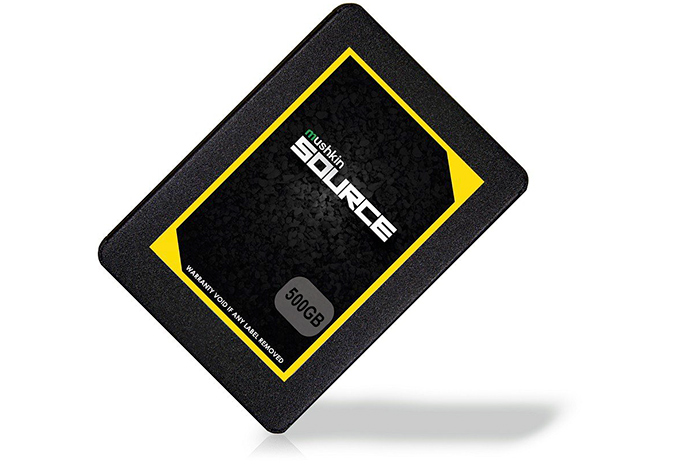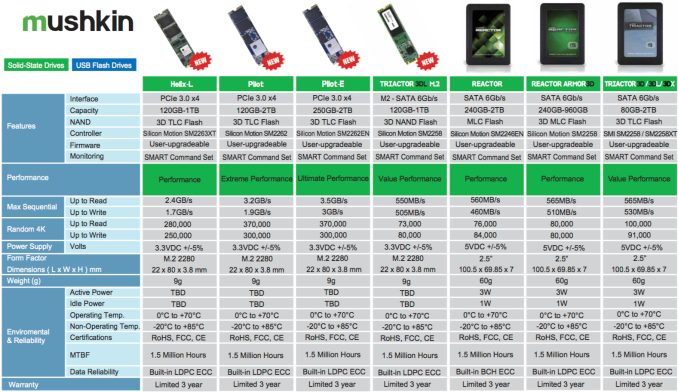Mushkin Launches Source SSDs: 3D TLC NAND, SATA, from $39 to $110
by Anton Shilov on March 30, 2018 2:00 PM EST
Mushkin has announced its new family of affordable SSDs primarily aimed at users who would like to upgrade their PCs featuring HDDs. The company’s Source drives use inexpensive 3D TLC NAND memory as well as a proven controller from Silicon Motion, allowing the company to start pricing at $39.
Mushkin’s Source family of SSDs includes three models featuring 120 GB, 250 GB, and 500 GB capacities. Mushkin says that 1 TB model will be included into the lineup at a later date, but does not elaborate. The drives come in a 2.5-inch/7mm form-factor and use a SATA interface, making them straightforward upgrades for existing desktops and mainstream laptops that use DFF storage devices. Muskin also plans to ship a M.2-2280 version of the Source family for ultra-thin notebooks sometimes in April. Mushkin’s Source drives are based on Silicon Motion’s SM2258XT controllers and 3D TLC NAND from an unnamed supplier, a combination that is frequently used by various SSD makers for their entry-level models these days.
On paper, the performance of Mushkin’s Source drives is comparable to other inexpensive SATA SSDs: up to 560 MB/s sequential write speed and up to 520 MB/s sequential write speed. As for random speeds, the manufacturer declares up to 75K 4K read IOPS as well as up to 81K write IOPS, which is somewhat lower than what we've seen in other 3D TLC-powered devices. Keep in mind that low-capacity SSDs usually perform slower than their higher-capacity counterparts, so for exact numbers check out the table below.
| Mushkin Source Specifications | ||||
| Capacity | 120 GB | 250 GB | 500 GB | 1 TB |
| Model Number | MKNSSDSR120GB | MKNSSDSR250GB | MKNSSDSR500GB | ? |
| Controller | Silicon Motion SM2258XT | |||
| NAND Flash | 3D TLC NAND | |||
| Sequential Read | 510 MB/s | 560 MB/s | ? | |
| Sequential Write | 440 MB/s | 515 MB/s | 520 MB/s | ? |
| Random Read IOPS | Up to 29K IOPS | Up to 54K IOPS | Up to 75K IOPS | ? |
| Random Write IOPS | Up to 79K IOPS | Up to 81K IOPS | Up to 81K IOPS | ? |
| Pseudo-SLC Caching | Supported | |||
| DRAM Buffer | No | |||
| TCG Opal Encryption | No | |||
| Power Management | DevSleep | |||
| Warranty | 3 years | |||
| MTBF | 1,500,000 hours | |||
| MSRP | $39 | $63 | $110 | ? |
The Source family of SSDs from Mushkin is the company’s fourth series of drives based on various types of 3D TLC NAND and Silicon Motion’s SM2258/SM2258XT controllers. Mushkin’s lineup already includes Triactor 3D, 3DL, and 3DX products, featuring capacity points ranging between 80 GB and 2 TB. It is noteworthy that based on the numbers from Mushkin’s product catalogue, its Triactor-series drives are faster when compared to the Source drives, but real-world performance of such SSDs isn't likely to be dramatically different.
All Mushkin Source SSDs are rated for 1.5 million hours MTBF and come with a three-year limited warranty. The drives are available now in the U.S.: the cheapest 120 GB version is priced at $39, the 250 GB flavor costs $63, whereas the 500 GB SKU is sold for $110. Keeping in mind that formally the Source family of SSDs are Mushkin’s lowest-end drives, expect their pricing to be very flexible.
Related Reading:
Source: Mushkin











42 Comments
View All Comments
jabber - Saturday, March 31, 2018 - link
Yeah but that aint going to work unless we suddenly get boards/chips with 60+ lanes.PixyMisa - Friday, March 30, 2018 - link
We need to switch to USB3 for internal drives. Can get 20Gbit/sec with USB 3.2, can use PCIe alt-mode, don't need a separate power cable, and any internal drive is automatically an external drive.ಬುಲ್ವಿಂಕಲ್ ಜೆ ಮೂಸ್ - Saturday, March 31, 2018 - link
Who is "we" ?I don't use any internal drives
StevoLincolnite - Friday, March 30, 2018 - link
SATA 4 of 1200 MB/s would actually be slower than Sata 3.2/Express that tops out at 1969 MB/s would it not?Lolimaster - Saturday, March 31, 2018 - link
If you feel bottlenecked by a sata3 drive, 1GB/s is not going to be enough either, NVME is the way to go. For non-prosumer usage 500MB/s is worthless as a performance metric.-Endurance
-4k random performance
-Warranty
Are the things you should worry about. Latency will be low but not that grade on certain usages in cheapo drives vs things like MX500 or 860 EVO.
Lolimaster - Saturday, March 31, 2018 - link
You can have a Sata SSD, NVME 4GB/s SSD, Optane or Ramdisk and your game will barely load a tiny bit faster compared to the "slow" sata SSD.CheapSushi - Saturday, March 31, 2018 - link
Would love if SFF-8643 or similar connectors became the norm. It's x4 PCIe lanes. But I'd like x1 lanes for drives. So instead of a bunch of SATA ports (even if SATA4), you have something like a SFF-8643, so you could do one x4 standard NVMe drive or two x2 NVMe drives or 4 x1 NVMe drives. Something super versatile. Have a row of 4, 5 or 6 of these on an enthusiast ATX board.CheapSushi - Saturday, March 31, 2018 - link
FYI I'm talking about bulk storage. I think a lot of people here just look at is as "HAVE ONE DRIVE FOR EVERYTHING" but personally I still want lots of drives for bulk storage, which is where QLC NAND will come in.ZeDestructor - Saturday, March 31, 2018 - link
There are 4 reasons why we won't be seeing SATA4 anytime soon:1. Power: in bps/W, PCIe is ahead of SATA
2. Latency: NVMe over PCIe is lower latency than SATA AHCI. Maybe NVMe over SATA/SAS is faster, but nobody's bothered, and I don't see anybody bothering
3. Scalability: SATA is limited to 1 lane. SAS brings it up to 2. Meanwhile, PCIe can do 1, 2, 4 8, 16, 24 and 32 (in theory it should be able to do any arbitrary number, but those are what I have seen actually implemented).
4. Cost and/or flexibility: with PCIe, you need no intermediate controllers between PCIe and SATA/SAS. In the event you need more physical ports than lanes, you can either bifurcate the PCIe root, or put a PCIe switch in there, instead of being forced to lop off a PCIe x8 or x16 slot just to dangle 8 slow harddrives off (guess who's dual-CPU server has 3 HBAs to control 24 drives...).
Conclusion: if you want a faster SSD, just buy one! Cause between NVMe and Optane, there's improvements in sequential speed, raw IOPS and low-QD IOPS.
ZeDestructor - Saturday, March 31, 2018 - link
Source for the power and latency: https://www.anandtech.com/print/7843/testing-sata-...